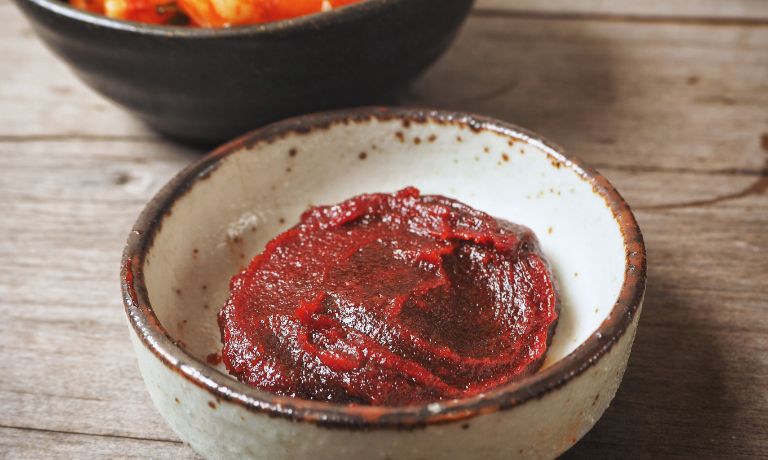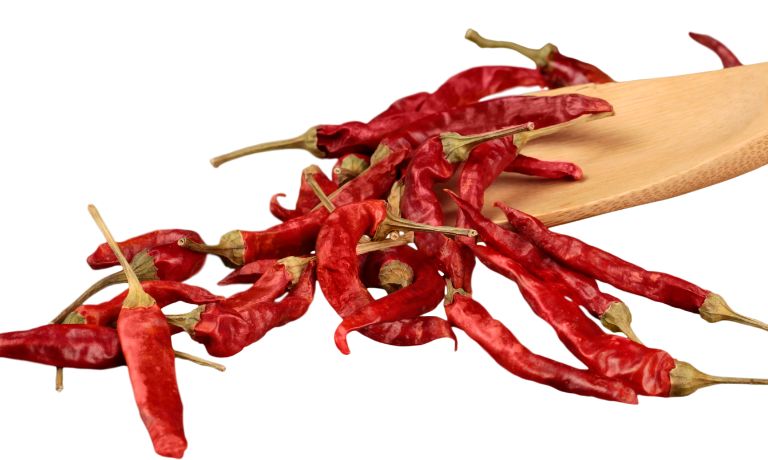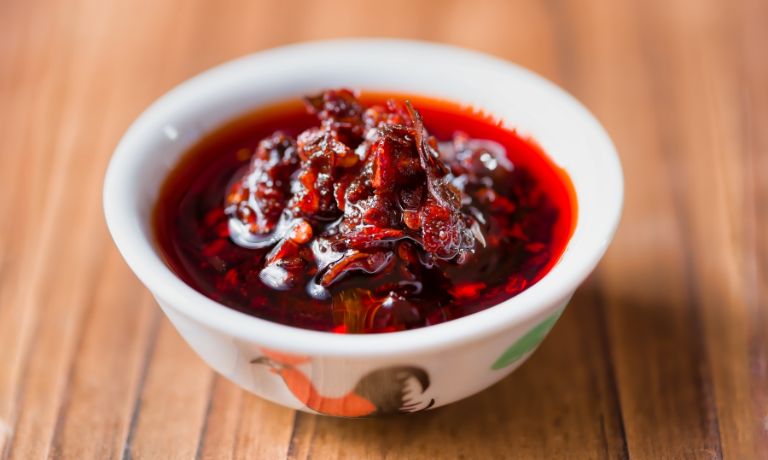If you love the flavor of chili oil but are looking for alternative options to it – no worries!
With its unique range of flavors and nutritious qualities, a wide variety of substitutes are available to fit your preferences.
This blog post will explore some different alternatives to traditional chili oil that still have a delicious taste.
Besides, we provide helpful tips on how to make each one create dishes bursting with flavor.
What Is Chili Oil?
Chili oil is an aromatic, savory condiment of hot chilies and oil.
It is often used as a flavor enhancer in Chinese cuisine but can also be used to spice up dishes from other regions.
The base for chili oil is typically vegetable or sesame oil, and the chilies used are usually dried red chilies, though other types of chilies can be used as well.
Chili oil is often used to add heat and flavor to stir-fried dishes, soups, marinades, and dipping sauces.
It can also be drizzled over vegetables or noodles for a spicy kick.
When using chili oil in cooking, remember that a little goes a long way since it is very spicy.
Remember to take the type of chilies and oil into consideration, as this will affect the flavor and heat of the chili oil.
For a milder version, opt for a lighter-colored oil such as canola or vegetable, and choose dried chilies that are low in heat, such as milder bird’s eye chilies.
For a spicier version, choose a darker-colored oil such as sesame or walnut, and add more dried red chili flakes.

Substitutes For Chili Oil
Chili oil is a popular ingredient that brings heat and flavor to various dishes.
However, if you don’t have chili oil or want something different, there are plenty of alternatives.
Sriracha
Sriracha is a hot sauce made from chili peppers, garlic, sugar, salt, and vinegar. It originated in Thailand but has become popular worldwide.
Sriracha can be used as an all-purpose condiment for both Asian and non-Asian dishes alike.
It is also often substituted in recipes that call for chili oil, as the main ingredients are similar.
[display-posts id=”2747″ image_size=”thumbnail” posts_per_page=”1″]
The flavor of Sriracha is often described as a combination of sweet and spicy, with a hint of garlic.
The heat level can vary depending on the brand or type, so it’s best to taste your sauce before adding it.
Additionally, sriracha can be used in place of chili oil when marinating or stir-frying vegetables, making sauces, and adding to soups for extra flavor.
It is also a great addition to any type of noodle dish.

Gochujang
Gochujang is a spicy and savory red chili paste popular in Korean cuisine.
It’s made from fermented soybeans, glutinous rice, chili pepper powder, malt powder, and salt.
Combining these ingredients gives Gochujang a unique flavor that can range from sweet to sour with a kick of heat.
Gochujang can be used as a condiment, marinade, or sauce. It adds a depth of flavor to dishes like soups, stews, noodles, and stir-fries.
It can sometimes be substituted for chili oil or combined with other ingredients, such as garlic and sesame oil, to create a unique flavor.

Sambal Oil
Sambal oil, sometimes called sambal oelek, is made from pure ground chilies and then simmered in oil.
It’s often used in Indonesian and Malaysian cuisines for its intense spicy flavor and aroma.
[display-posts id=”2659″ image_size=”thumbnail” posts_per_page=”1″]
Sambal oil can substitute for chili oil in various dishes, such as stir-fries, marinades, and sauces.
Its unique flavor adds depth to dishes without overwhelming them with too much heat.
Sambal oil can also be used as a tabletop condiment alongside other dipping sauces or as a finishing touch to dishes like noodles and dumplings.
Whether you want to add a bit of heat or completely transform a dish, sambal oil is an excellent alternative to traditional chili oil.

Chili Flakes
Chili Flakes, also known as red pepper flakes, are dried and crushed chilis ground into small flakes.
They typically have mild to moderate heat and can be used instead of chili oil for added flavor and heat.
Chili Flakes are great for adding a little kick to pizzas, pasta, soups, and stir-fries.
They can be used as a garnish for salads, tacos, sandwiches and more!
In addition to their wonderful flavor, Chili Flakes can help relieve congestion due to colds and allergies.
Adding a pinch of Chili Flakes to your meals can help clear sinuses and relieve chest congestion.

Dried Pepper
Dried pepper is a type of dried chili that can be used as a substitute for chili oil.
It is usually made by drying and grinding fresh chilies, or the seeds from the peppers.
The result is a powdery spice with a pungent aroma and flavor.
[display-posts id=”2649″ image_size=”thumbnail” posts_per_page=”1″]
Dried pepper can be added to sauces, salsas, and other dishes for a spicy, smoky flavor.
It can also be used in place of chili oil for sautéing vegetables, marinating meats, or creating dressings and sauces.
When substituting dried pepper for chili oil, remember that the peppers are much more potent than the oil, so you’ll need to use less.
You also need to consider the heat level of the peppers you use – some are milder than others.
It’s best to start with a smaller amount, taste as you go, and adjust accordingly.

Cayenne Pepper
Cayenne pepper is a chili pepper that has been dried, ground into a powder and used as a spice in cooking.
It has an intense heat level and pungent flavor that can vary from mild to very hot.
Cayenne is often blended with other spices, such as garlic or oregano, for added depth of flavor.
It can be used to season dishes, as a condiment, or as an ingredient in sauces and marinades.
When substituting, it is best to use the same amount of cayenne as you would chili oil, as the flavor will be stronger.
Cayenne is also excellent for adding a kick of heat to dishes without overpowering them.
At the same time, chili oil can be overpowering or even too mild, depending on its quality.

Sichuan Sauce
Sichuan Sauce is a traditional Chinese condiment made with minced garlic, chili pepper, fermented black beans and other spices.
It is also known as “ma la sauce” or “ting ma jiang”.
The sauce is typically used to add flavor to various dishes such as hot pots, stir-fries, and noodles.
This sauce is known for its spiciness as it contains chili pepper, which can provide a fiery kick to the dish.
It also has a savory flavor with hints of garlic and fermented black beans.
[display-posts id=”2630″ image_size=”thumbnail” posts_per_page=”1″]
The difference is that chili oil is typically made with vegetable oils and chili flakes, while Sichuan Sauce uses a blend of spices, which adds more complexity to the flavor.
The garlic and fermented black beans give it a unique taste that distinguishes it from chili oil.
Additionally, the sauce might be less spicy than chili oil so that you can adjust the spiciness to your liking.

FAQs
Can I Use Sriracha Instead Of Chili Oil?
Yes, Sriracha is a great alternative to chili oil.
It has a similar flavor profile and can be used in most recipes that call for chili oil.
Additionally, it adds a nice kick of heat without being overly spicy.
What Is A Non-Spicy Replacement For Chili Oil?
If you’re looking for a non-spicy alternative to chili oil, then garlic or ginger paste may be a good option.
Both of these offer a subtle flavor that can be used to replace the heat provided by chili oil.
What Is The Main Application For Chilli Oil?
Chili oil is most commonly used as a condiment or seasoning in Chinese dishes, but it can also be used to flavor soups, stir-fries, noodles, and other dishes.
Conclusion
Chili oil is an excellent condiment to add flavor and heat to dishes, but it’s not the only option.
There are several options that you can substitute for chili oil that can provide a similar level of spice and complexity of flavor.
These include Chili Flakes, Dried Pepper, Cayenne Pepper and Sichuan Sauce.
The best substitute will depend on the recipe and your desired level of spiciness.
Experiment with a few different substitutes to find the perfect one for you!

